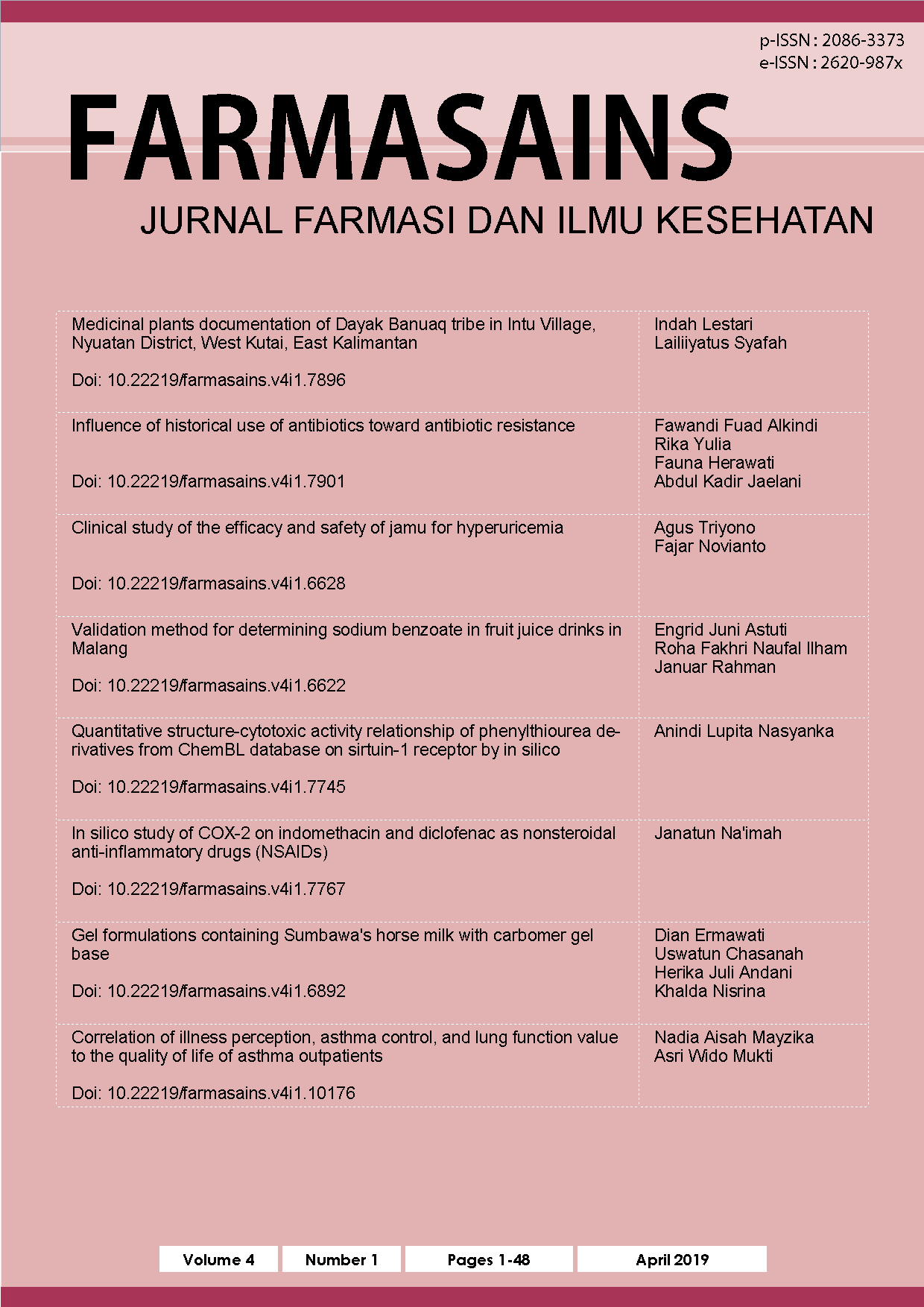In silico study of COX-2 on indomethacin and diclofenac as nonsteroidal anti-inflammatory drugs (NSAIDs)
DOI:
https://doi.org/10.22219/farmasains.v4i1.7767Keywords:
COX-2, Indomethacin, Diclofenac, Molecullar dockingAbstract
Cyclooxygenase is an enzyme that plays a role in the formation of prostaglandins, which can cause inflammation and pain when overexpressed. This study aims to determine the interaction between COX-2 macromolecules (receptors) with their ligands, namely indomethacin and diclofenac in silico using the Molecular Docking method. The COX-2 receptor was downloaded in the form of a 3D structure from the RCSB GDP with code 5F19. Diclofenac Ligand and Indomethacin were downloaded in the form of a 3D structure from the RCSB GDP with 4ZBQ code and 4IK7 code. The results showed that the interaction between COX-2 and indomethacin was the interaction of hydrogen, which linked indomethacin with amino acid Leu531 and steric interactions between indomethacin and amino acids Trp387, Tyr385, Tyr355, Leu352, and Val523. The interaction of [COX-2 – Indomethacin] produces a value of ∆G of -103.136 kcal/mol, and the value of RMSD is 1.244 Å. Whereas, the interaction that occurs in COX-2 with diclofenac is the steric interaction that happens between diclofenac with amino acids Leu390, Trp387, Gln203, His388, His207, and Thr206. The interaction parameter between [COX-2-Diclofenac] obtained ∆G value of -7.843 kcal/mol and an RMSD value of 2.07851 Å.
Downloads
References
Chandrasoma, P., & Taylor, C. R. (2005). Ringkasan Patologi Anatomi. Jakarta, Indonesia: Penerbit Buku Kedokteran EGC.
Gilman, A. G. (2012). Goodman & Gilman Dasar Farmakologi Terapi Edisi 10. Jakarta, Indonesia: Penerbit Buku Kedokteran EGC.
Kulmacz, R. J., van der Donk, W. A., & Tsai, A. L. (2003). Comparison of The Properties of Prostaglandin H Synthase-1 and -2. Progress in Lipid Research, 42(5), 377-404.
Kumar, V., Coltran, R. S., & Robbins, S. L. (2012). Robbins Buku Ajar Patologi Edisi 7 Volume 2. Jakarta, Indonesia: Penerbit Buku Kedokteran EGC.
McDonald, B. (2016). Stoelting’s Pharmacology & Physiology in Anesthetic Practice—5 th Edition. Canadian Journal of Anesthesia/Journal canadien d'anesthésie, 63(3), 370-371.
Rouzer, C. A., & Marnett, L. J. (2003). Mechanism of Free Radical Oxygenation of Polyunsaturated Fatty Acids by Cyclooxygenases. Chemical Reviews, 103(6), 2239-2304.
Rouzer, C. A., & Marnett, L. J. (2009). Cyclooxygenases: Structural and Functional Insights. Journal of Lipid Research, 50(Supplement), S29-S34.
Serhan, C. N., & Oliw, E. (2001). Unorthodox Routes to Prostanoid Formation: New Twists in Cyclooxygenase-Initiated Pathways. The Journal of Clinical Investigation, 107(12), 1481-1489.
Wilmana, P. F., & Gunawan, S, G. (2012). Analgesik-Antipiretik Analgesik Anti-Inflamasi Nonsteroid dan Obat Gangguan Sendi Lainnya. In S. G. Gunawan (Ed.), Farmakologi dan Terapi Edisi 5 (Cetak ulang dengan Tambahan, 2012) (pp. 230-246). Jakarta, Indonesia: Badan Penerbit FKUI.
Downloads
Published
How to Cite
Issue
Section
License
Copyright (c) 2019 Janatun Na'imah

This work is licensed under a Creative Commons Attribution 4.0 International License.
Authors who publish with this journal agree to the following terms:
a. Authors retain copyright and grant the journal right of first publication with the work simultaneously licensed under a Creative Commons Attribution License that allows others to share the work with an acknowledgement of the work's authorship and initial publication in this journal.
b. Authors are able to enter into separate, additional contractual arrangements for the non-exclusive distribution of the journal's published version of the work (e.g., post it to an institutional repository or publish it in a book), with an acknowledgement of its initial publication in this journal.
c. Authors are permitted and encouraged to post their work online (e.g., in institutional repositories or on their website) prior to and during the submission process, as it can lead to productive exchanges, as well as earlier and greater citation of published work (See The Effect of Open Access).













